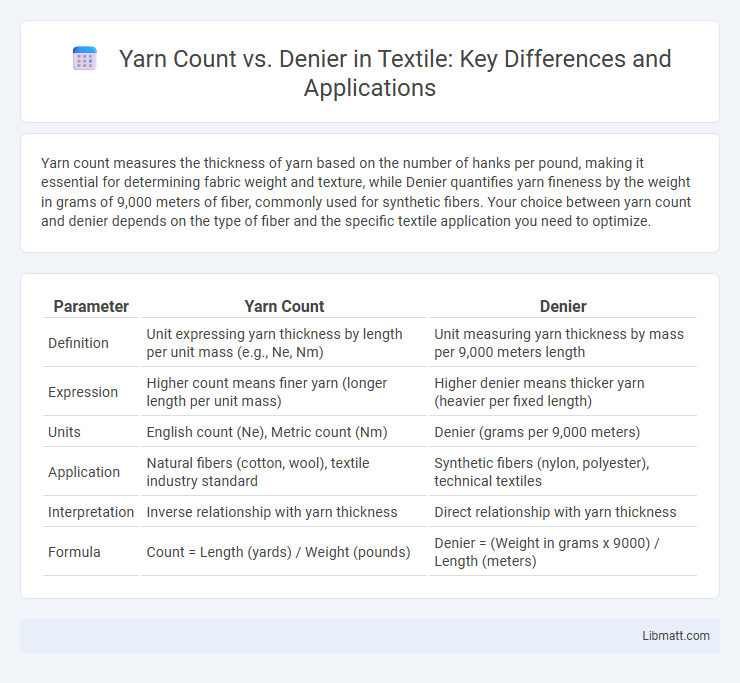Yarn count measures the thickness of yarn based on the number of hanks per pound, making it essential for determining fabric weight and texture, while Denier quantifies yarn fineness by the weight in grams of 9,000 meters of fiber, commonly used for synthetic fibers. Your choice between yarn count and denier depends on the type of fiber and the specific textile application you need to optimize.
Table of Comparison
| Parameter | Yarn Count | Denier |
|---|---|---|
| Definition | Unit expressing yarn thickness by length per unit mass (e.g., Ne, Nm) | Unit measuring yarn thickness by mass per 9,000 meters length |
| Expression | Higher count means finer yarn (longer length per unit mass) | Higher denier means thicker yarn (heavier per fixed length) |
| Units | English count (Ne), Metric count (Nm) | Denier (grams per 9,000 meters) |
| Application | Natural fibers (cotton, wool), textile industry standard | Synthetic fibers (nylon, polyester), technical textiles |
| Interpretation | Inverse relationship with yarn thickness | Direct relationship with yarn thickness |
| Formula | Count = Length (yards) / Weight (pounds) | Denier = (Weight in grams x 9000) / Length (meters) |
Understanding Yarn Count: A Basic Overview
Yarn count measures the thickness or fineness of yarn based on the length per unit weight, commonly expressed in units like cotton count (Ne) or metric count (Nm). Denier, on the other hand, quantifies yarn mass by the weight in grams of 9,000 meters of yarn, primarily used for synthetic fibers. Understanding yarn count is essential for textile manufacturing as it directly influences fabric weight, texture, and end-use suitability.
What is Denier? Definition and Importance
Denier is a unit of measurement that quantifies the linear mass density of fibers, defined as the weight in grams per 9,000 meters of fiber. It plays a crucial role in the textile industry by determining the thickness, texture, and durability of yarns, directly impacting fabric quality and performance. Understanding denier helps you select the right material for specific applications, from lightweight hosiery to heavy-duty industrial fabrics.
Yarn Count vs Denier: Key Differences
Yarn count measures the length of yarn in relation to its weight, typically expressed in units such as English cotton count or metric count, while denier quantifies the yarn's mass per 9,000 meters, indicating fiber thickness. Yarn count is inversely proportional to yarn thickness--higher counts mean finer yarns--whereas higher denier values correspond to thicker, heavier yarns. Understanding these key differences is vital for selecting appropriate yarns in textile production based on fabric weight, texture, and end-use requirements.
How Yarn Count is Measured
Yarn count is measured by determining the length of yarn per unit weight, typically expressed as the number of hanks (each hank equals 840 yards) per pound in the English system or meters per gram in the metric system. This measurement helps evaluate the fineness of yarn, with higher counts indicating finer yarns. Your choice between yarn count and denier depends on the fiber type and fabric application, as denier measures the weight in grams of 9000 meters of yarn, focusing more on the yarn's thickness.
Measuring Denier: Methods and Standards
Denier is measured by the weight in grams of 9,000 meters of yarn, providing a quantifiable metric of fiber thickness widely used in the textile industry. Methods for measuring denier include gravimetric analysis and automated systems that ensure precision according to international standards such as ASTM D1577, guaranteeing consistency in yarn classification. Accurate denier measurement is critical for quality control in fabric production, impacting durability, texture, and end-use performance.
Applications in Textile Industry
Yarn count and denier are critical parameters influencing fabric properties and end-use applications in the textile industry. Yarn count measures the length per unit weight, commonly used for cotton and wool, affecting softness and drape in apparel and home textiles. Denier, indicating fiber thickness by weight in grams per 9,000 meters, is essential for synthetics like nylon and polyester, determining durability and texture for industrial fabrics, upholstery, and activewear.
Impact on Fabric Quality and Performance
Yarn count and denier directly influence fabric quality and performance, with yarn count measuring the fineness of yarn based on length per unit weight, while denier quantifies yarn thickness by weight per 9,000 meters. Higher yarn counts produce finer, smoother fabrics ideal for lightweight, breathable textiles, whereas lower denier yarns offer increased durability and resistance, making them suitable for heavy-duty applications. Selecting the appropriate yarn count and denier balances fabric strength, texture, and functionality, optimizing performance for specific end-uses such as apparel, upholstery, or industrial materials.
Choosing Between Yarn Count and Denier
Yarn count and denier are key metrics in textile manufacturing that measure fiber thickness but serve different purposes. Yarn count quantifies the length of yarn per unit weight, ideal for natural fibers like cotton, whereas denier measures the mass in grams per 9,000 meters, commonly used for synthetic fibers such as nylon. Selecting between yarn count and denier depends on the fiber type and end-use requirements, ensuring accurate fabric strength, texture, and weight assessments.
Common Misconceptions and Mistakes
Yarn count and denier are often confused, but they measure different aspects: yarn count indicates the length of yarn per unit weight, while denier measures the mass in grams per 9,000 meters of yarn. A common mistake is assuming higher yarn counts mean thicker yarns, whereas higher denier values actually indicate thicker fibers. Understanding the distinction helps you select appropriate materials for specific textile applications and avoid errors in fabric strength or appearance.
Summary: Selecting the Right Metric for Your Needs
Yarn count measures the length of yarn per unit weight, commonly used for natural fibers like cotton, emphasizing fineness and texture. Denier quantifies the mass in grams per 9,000 meters of yarn, ideal for synthetic fibers, highlighting thickness and durability. Choosing between yarn count and denier depends on fiber type and end-use requirements, ensuring precise control over fabric quality and performance.
Yarn count vs Denier Infographic

 libmatt.com
libmatt.com